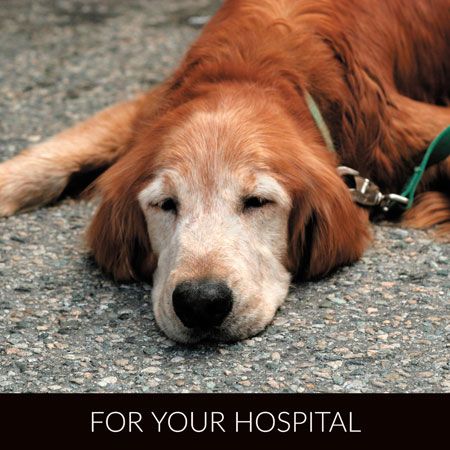Increase your senior savvy
Weve scoured our site to bring you a collection of some of our favorite senior care tips to use in your veterinary clinic and to send home with your clients.

Getty Images1. Know your role
Receptionists: When clients with senior pets call to make an appointment, ask them to withhold food from their pets for four to six hours before the visit in case the doctor wants to run lab tests. Then remind them that when they come in, they should keep their pets from watering the bushes so they'll be ready for a urinalysis. Tell owners of seniors and seniors-to-be that their pets have entered a new life stage and you'll schedule their appointments to last five to 10 minutes longer than usual to allow time for the doctor to go over the pets' changing needs. Also keep clients committed to senior care by following up to make sure they're complying with recommended at-home care.
Technicians and assistants: A thorough history is the starting point of any wellness program, especially one for seniors. Observant owners can detect subtle changes in their pets' activity levels, elimination patterns, or behavior. So be sure to listen for comments like, “She's always thirsty,” which might indicate diabetes. Also continually quiz yourself on common senior conditions and which tests you'd run to detect them. The better you understand the diagnostics, the better you'll be able to explain them to clients.
Managers: Design a marketing strategy for your senior program. Use newsletters, reminders, and invoices to educate your clients-and team members-on age-related problems. Then keep team members up to date on senior protocols and trends with CE seminars. One idea: Find the team member with the best compliance rates for senior screens and ask him or her to share tips with the rest of the team.
Veterinarians: Delegating the completion of lab tests to qualified technicians gives veterinarians more time for diagnosing and treating. But doctors shouldn't completely pass on the responsibility of client education. When veterinarians and team members explain the importance of senior care to clients, the chances of compliance increase.

Joy Brown/Shutterstock.com2. Build a senior wellness plan
You'll need the following two ingredients:
Comprehensive package: In order to determine which diagnostic tests to run, first you need to know what you're looking for, says Caitlin Rivers, a Firstline Editorial Advisory Board member and technician trainer at Metzger Animal Hospital in State College, Pa. Common conditions older pets are likely to develop include-but aren't limited to-obesity and periodontal, heart, kidney, liver, and thyroid disease. To rule these diseases in or out, a basic senior wellness package should include a wellness exam, senior, chemistry, and complete blood work panels, electrolyte checks, and urinalysis, Rivers says. (For senior tests at a glance, click here.)
Setting your practice's approach to nutrition and exercise is also vital to your senior program because obesity directly contributes to the incidence of osteoarthritis, Type 2 diabetes, and hypertension-all conditions that crop up in older pets. Many practices recommend-and carry-special diets to control obesity and its related illnesses. Many also suggest nutritional supplements to ease arthritis pain. But don't try to stock every food-related product available. “You should only pick stuff that you'll actually recommend,” Rivers says.
Patient database: It's no secret pets age faster than people. But when should you start talking to clients about senior care? As a general rule, pets are considered seniors at 7 years old. But that's not a magic number. “The best time to start talking about senior wellness is before patients need it,” Rivers says. Then watch each pet individually, says Gina Toman, a Firstline Editorial Advisory Board member and practice manager at Seaside Animal Care in Calabash, N.C.
“Certain breeds age differently so look at the average life span,” Toman says. Periodontal disease is appearing earlier and earlier in smaller breeds, Toman says, so it's smart to start screening those dogs at 4 years of age. It's a good idea to set up a system in your records to flag full-fledged and soon-to-be seniors so there's a visual reminder to get the discussion going.
To download a sample senior wellness letter to send or e-mail clients, click here.
BONUS: Click here to download a senior wellness report card.

Getty Images3. Give senior pets a pass
Standing and sitting over and over again can be uncomfortable for elderly pets. Taking them directly to an exam room eliminates some of the ups and downs that get them down during a veterinary visit.
Sharon DeNayer
4. Go easy on the eyes
As pets age, their vision may suffer as well. Often older patients are more likely to develop cataracts or retinal degeneration. To help these patients feel more safe and comfortable, try to reserve a room off to the side, in a quieter area of the hospital. This way patients will be less likely to be startled by loud noises near kennel housing or a treatment area. Placing a bell on your shoe or pant leg will signal to blind patients when you're entering the room or coming near.
Talk to your clients with blind pets to see what they do at home to make their pet more comfortable, and try to follow their lead in the hospital. To avoid collisions with furniture within the hospital, take a scented spray or oil-nothing too strong or irritating-and spray corners in the patient's path on the way to the exam room. For example, if the pet has to pass a reception counter, apply some scented oil to the edge the pet will approach first.
Team members should use short leashes when moving these patients from one area of the hospital to another, such as the trip from exam room to treatment. This way there's less likelihood of patients wrapping around walls where they can't be monitored. This also reduces the chances they'll run into objects and injure themselves-or unknowingly sneak up on a roaming hospital-owned pet and cause an altercation.
Oriana D. Scislowicz, BS, LVT
5. Engage in some pillow talk
Most elderly patients lose muscle mass as they age, and they may also suffer from painful joints. So providing cushioning for them to lie on is vital to your hospital's setup. The waiting room as well as the exam rooms should include cushion seating instead of a hard floor and hard seating. For an inviting, home-like option, place booths in the lobby area with large cushions and pillows. Your clients will thank you, too. You may also choose individual seats and offer large, comfortable dog bedding on the floor.
In exam rooms, use cushioned seats. And for larger dogs, provide big, fluffy dog beds. Your typical feline patients will, of course, make themselves at home on these as well. Then neatly place extra bedding for pets, such as comforters or blankets, off to the side or in a trunk in the exam room.
Oriana D. Scislowicz, BS, LVT

Getty Images6. Warm up
Pets always appreciate a warm towel on an exam table, and you can drape or wrap small animals in a towel. You can also spray the towels with synthetic feline facial pheromones or dog-appeasing pheromones before warming.
Sharon DeNayer
7. Give ‘em a grip
An unused yoga mat can be put to good use by cutting it in half and using it for traction and additional cushion for unsteady dogs. The mats are inexpensive, easy-to-clean, and impervious to nail punctures. Even better, you can roll them up for storage.
Jennifer L. Koehl, VMD
8. Support with surgical gowns
We needed a way to support dogs that are nonambulatory or very weak in the hindlimbs, so I made slings by rolling up the main torso parts of old surgical gowns and wrapping them in Vetrap (3M). We use the arms of the gowns to hold patients up. These makeshift slings allow us to support a patient while it walks, assist older dogs so they don't slip, help with rehabilitation after orthopedic surgeries, or keep a dog in a standing position for a neurologic exam. We even send these slings home with owners.
Emily Hoppmann, DVM
9. Offer accident forgiveness
Incontinence often comes along with old age. And many owners use diapers at home to help control accidents. Hospitals can make patients more comfortable and relieve some of pet owners' stress by keeping extra diapers in the hospital in case pets need to be changed and clients forget extras. Using puppy pads in the waiting area and exam room can also help control inevitable accidents.
Oriana D. Scislowicz, BS, LVT
10. Made medication simple
Stocking your pharmacy with medications to help treat cognitive disorders and incontinence, arthritis supplements, and the latest pain management drugs can help maintain a level of comfort for these pets. This way you offer convenience and improve the chances pet owners will follow your recommendations. Oftentimes, owners with older pets feel discouraged when it comes to treating these ailments. Easy access to these therapies can mean the difference between an owner feeling like the pet's quality of life is poor and feeling a sense of hope. If you have properly trained team members, offering massage, acupuncture, and acupressure can help these patients with chronic pain or arthritic joints.
Oriana D. Scislowicz, BS, LVT

Getty Images1. Give osteoarthritis patients a stretch
We teach our pet owners to do passive range of motion and stretching exercises that can be done at home. For example, when they are watching TV at night and the pet's lying next to them on its side, they may be able to do some stretches or bicycle range of motion exercises. Arthritic pets that don't move normally because it hurts can benefit from passive range of motion. And for pets who have muscle atrophy, simple exercises like 3 legged standing can be done at home. Consider developing an exercise program to send home with clients.
Another great hack for general practitioners? Get up to date with intra-articular injections for osteoarthritic pets. There are many products in the market now, and data is being collected that shows these injections can relieve the symptoms of osteoarthritis without the side effects seen with the use of oral medications.
Debra Canapp, DVM, CCRT, CVA, DACVSMR
2. Mitigate motion sickness
For years, one of our patients vomited every time it rode in a car. Countless cleanups later, we performed a minor surgical procedure on the senior cat that necessitated the placement of an Elizabethan collar. Miraculously, for the first time in its traveling life, the cat did not vomit on the way home, and, still wearing the E-collar, the cat didn't vomit on the way back to the clinic for suture removal. Since then, I have suggested E-collars as a treatment for car sickness for more than a dozen cats and even a couple of dogs, and, anecdotally, it seems to work.
Tom Morganti, DVM
3. Warn with wind chimes
I have had several owners of blind pets worry that their pets will fall down the stairs or off the deck. I suggest placing wind chimes near the dangerous site, so a pet can orient itself and learn to associate the sound with the nearby hazard.
Linda M. Connolly, DVM